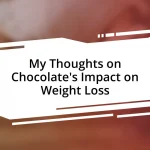Key takeaways:
- Craft chocolate brands prioritize sustainable sourcing, fair trade practices, and small-batch production, enhancing flavor and quality.
- Key benefits of craft chocolate include superior flavor, ethical practices, health-conscious ingredients, and a positive community impact.
- Choosing quality chocolate involves looking for high cocoa content, minimal ingredients, and ethically sourced cacao to ensure better taste and transparency.
- Sustainable practices in chocolate production focus on eco-friendly sourcing, direct farmer relationships, and reducing carbon footprints, benefiting both communities and the environment.

Understanding Craft Chocolate Brands
Craft chocolate brands are all about passion and quality, focusing on sustainably sourced ingredients and small-batch production. I remember the first time I tasted a truly artisan bar; the flavor was so intense, it felt like a revelation. How could something as simple as chocolate carry so many stories?
Many craft chocolatiers work closely with farmers, ensuring fair trade practices and high-quality beans. This connection often leads to unique flavor profiles that mass-produced chocolate just can’t replicate. I still think back to a bar infused with sea salt and chili; the bursts of flavor created an experience that danced on my palate. Have you ever had a chocolate that transported you somewhere completely different?
The beauty of craft chocolate lies not only in its taste but also in the intention behind each bar. The process involves careful roasting, conching, and tempering, resulting in a range of textures and aromas that can be customized. Every bite reflects the artistry of the chocolatier, which is something I appreciate more as I explore different brands. What’s your favorite craft chocolate memory?

Benefits of Choosing Craft Chocolate
When I think about craft chocolate, the allure goes beyond just taste; it’s a sensory journey that often brings to mind the warmth of sharing a moment with friends. Each bar tells a story, and I can still remember the delight of discovering a local chocolatier and their limited edition raspberry-infused chocolate. That experience was more than just enjoying a sweet treat; it was about savoring the dedication to craftsmanship that went into every piece.
Here are some key benefits of choosing craft chocolate:
- Superior Flavor Quality: Small-batch production allows for unique flavor combinations and a focus on rich, complex tastes.
- Sustainable Sourcing: Many craft brands prioritize ethically sourced cacao, promoting fair trade and supporting farmers.
- Artisanship: Craft chocolate makers genuinely invest time and care into their products, leading to exquisite textures and quality.
- Healthier Ingredients: Often, these chocolates contain fewer additives, relying on raw or natural ingredients that enhance both flavor and health benefits.
- Community Impact: Supporting local chocolatiers fosters a sense of community and helps sustain local economies.
Each time I dive into those intricate flavors, I’m reminded of the deep connections with people and places that craft chocolate nurtures.

How to Choose Quality Chocolate
Choosing quality chocolate can seem daunting, but there are a few key elements to look for when seeking out the best bars. First, high cocoa content is crucial; I usually opt for chocolate that contains at least 70% cocoa because it provides a more robust flavor without being overly sweet. Recently, I tried a 75% bar with hints of espresso that completely blew me away—each piece was a perfect balance of richness and bitterness. Have you ever experienced a chocolate that made you savor every bite?
Next, I find it helpful to read the ingredient list. Quality chocolate should have minimal ingredients: cocoa mass, cocoa butter, and sugar—that’s it. It’s a good sign when I see that the chocolate uses real vanilla rather than artificial flavorings. A few weeks ago, I stumbled upon a brand with just three ingredients, and the flavor was pure and delightful. Isn’t it amazing how transparency can enhance the overall experience?
Finally, consider the source of the cacao. Ethical sourcing not only supports farmers but often results in more complex flavors. I remember tasting a bar made from single-origin cacao from Madagascar; its fruity notes transported me to a sun-soaked plantation. Have you thought about where your chocolate comes from? Understanding the journey of each bar elevates the tasting experience.
| Criteria | What to Look For |
|---|---|
| Cocoa Content | At least 70% for richer flavor |
| Ingredient List | Minimal ingredients; no artificial additives |
| Sourcing | Ethically sourced, preferably single-origin |

Tasting Notes in Craft Chocolate
When I indulge in craft chocolate, I’m often met with a symphony of tasting notes that surprise and delight me. For instance, I recently sampled a bar that boasted floral undertones reminiscent of hibiscus, leading to a luscious cherry finish. Isn’t it fascinating how different cacao origins can evoke such a diverse range of flavors, almost like sipping a fine wine?
On another occasion, I tried a dark chocolate infused with chili and sea salt; the heat slowly unfolded with each bite, offering a perfect contrast to the rich cocoa. I realized in that moment that chocolate tasting can be a personal exploration, where you discover not just flavors but emotions attached to each experience. What emotions do you connect with when tasting craft chocolate?
The art of crafting chocolate often means that every small batch can introduce brand-new tasting notes. I remember one that accentuated caramel and nutty flavors—each nibble took me down memory lane, reminiscent of cozy evenings spent around a fireplace. It’s incredible how a simple piece of chocolate can spark such vivid memories and sensations, right? These multi-layered flavors create an experience that goes beyond mere consumption; they become stories we cherish.

Popular Craft Chocolate Brands
One of my favorite craft chocolate brands has to be Dandelion Chocolate. Based in San Francisco, they take pride in sourcing their cocoa beans directly from farmers, ensuring not just quality, but also a connection to the communities behind the product. I remember visiting their shop and sampling a 70% bar made with beans from Belize; the hints of tropical fruit were so vivid that it felt like a little slice of the rainforest in my mouth. Have you ever tasted a chocolate that felt like a journey?
Then there’s Vivo Life Chocolate, a brand I discovered during a wellness retreat. Their cold-pressed chocolate bars are not only delicious but are also filled with superfoods. One evening, I savored their matcha-infused dark chocolate while enjoying a sunset, which turned that moment into something truly magical. It made me think—how can chocolate be both a treat and a health boost?
Lastly, I can’t overlook the impact of small-batch producers like Taza Chocolate. Their stone-ground chocolate has a unique texture that surprised me the first time I bit into it. I recall the delightful crunch as it melted; it was reminiscent of childhood adventures at the chocolate factory. Isn’t it refreshing to enjoy a brand that embraces the imperfections of craft while delivering bold flavors? Each of these brands brings a distinct personality to the craft chocolate world, making every bite uniquely special.

Sustainable Practices in Chocolate Production
Sustainable practices in chocolate production are increasingly becoming a cornerstone for many brands in the craft chocolate scene. When I attended a workshop on sustainable sourcing, I was amazed to learn how some companies establish direct relationships with cacao farmers. This connection not only ensures fair wages but also promotes biodiversity and protects the ecosystems where cacao is grown. Have you ever considered how your chocolate choices impact the environment?
I remember tasting a bar from a brand that proudly showcased their commitment to eco-friendly practices. The label highlighted that their cacao was grown using agroforestry techniques, which integrate crops with tree planting. As I savored the rich chocolate, I found solace in the fact that my indulgence supported a system that nurtures the land. It’s a beautiful reminder of how sourcing matters—each bite can be a step towards sustainability.
Additionally, I often reflect on how brands are working to reduce their carbon footprints by utilizing renewable energy in their production processes. One brand I explored even shared that they were working towards zero waste in their facilities. It got me thinking: what if all companies followed their lead? I believe that when we choose sustainable chocolate, we’re not just satisfying our cravings; we contribute to a larger mission of preserving our planet for future generations. Isn’t that a sweet thought?














